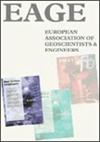钻孔 GPR 数据处理和可视化的新方法--应用于未爆弹药探测
IF 1.1
4区 地球科学
Q3 GEOCHEMISTRY & GEOPHYSICS
引用次数: 0
摘要
钻孔探地雷达(BGPR)测量可探测地下的物体和结构,通常用于探测未爆弹药(UXO)。如果使用反射模式的全向钻孔天线进行测量,则只有对来自多个钻孔的数据进行分析,才能确定未爆弹药的位置。数据分析通常仍由人工拾取反射数据完成。我们提出了新颖的方法,以更先进、更吸引人的方式处理和可视化 BGPR 测量数据。其中,雷达图中记录的反射能量被投射回钻孔周围三维空间中的所有潜在反射点。如果考虑到投影方向,我们就能得到矢量化的能量投影图像。投射能量的叠加可产生一个易于掌握的指标,显示未爆炸弹药的可能位置以及需要进行更详细调查的相关区域。这些方法已应用于合成数据和在埋有未爆弹药的试验场测量的数据。结果表明,能量投影是 BGPR 数据可视化的有用工具,尽管其结果取决于数据预处理。所提出的方法基于一种客观算法,为 BGPR 数据提供了新的表示方法,至少可以补充传统方法的不足。本文章由计算机程序翻译,如有差异,请以英文原文为准。
Novel approaches of borehole‐GPR data processing and visualization – application for unexploded ordnance detection
Borehole ground‐penetrating radar (BGPR) measurements allow for the detection of objects and structures in the subsurface and are often applied to the detection of unexploded ordnance (UXO). If omnidirectional borehole antennas in reflection mode are used for the measurement, the localization of UXO is only possible if the data from a multitude of boreholes are analysed. Data analysis is usually still done by manual picking of reflections. We propose novel approaches to process and visualize data from BGPR measurements in a more advanced and appealing manner. Therein, the reflected energy recorded in the radargrams is projected back to all potential reflection points in the three‐dimensional space around the boreholes. If the projection direction is considered, we obtain a vectorized energy projection image. Superposition of projected energy yields an easy‐to‐grasp indicator of possible locations of UXO and of regions of interest that ought to be investigated in more detail. These approaches have been applied to synthetic data and to data measured on a test site with buried UXO. The results show that energy projection is a useful tool for BGPR data visualization, although the result is dependent on data pre‐processing. The proposed methods provide novel representations of BGPR data based on an objective algorithm which will at least complement the conventional methods.
求助全文
通过发布文献求助,成功后即可免费获取论文全文。
去求助
来源期刊

Near Surface Geophysics
地学-地球化学与地球物理
CiteScore
3.60
自引率
12.50%
发文量
42
审稿时长
6-12 weeks
期刊介绍:
Near Surface Geophysics is an international journal for the publication of research and development in geophysics applied to near surface. It places emphasis on geological, hydrogeological, geotechnical, environmental, engineering, mining, archaeological, agricultural and other applications of geophysics as well as physical soil and rock properties. Geophysical and geoscientific case histories with innovative use of geophysical techniques are welcome, which may include improvements on instrumentation, measurements, data acquisition and processing, modelling, inversion, interpretation, project management and multidisciplinary use. The papers should also be understandable to those who use geophysical data but are not necessarily geophysicists.
 求助内容:
求助内容: 应助结果提醒方式:
应助结果提醒方式:


